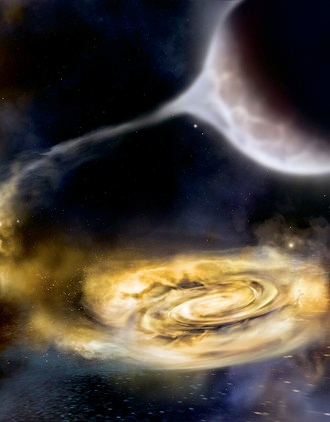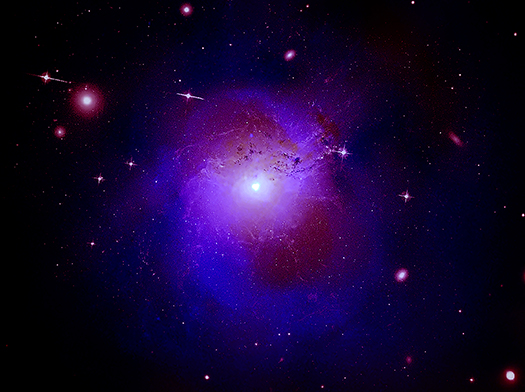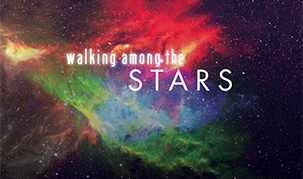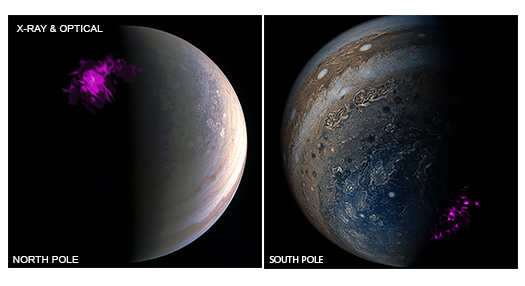The Billion-year Race Between Black Holes and Galaxies: Guang Yang

Guang Yang
We welcome Guang Yang, a 4th-year Astronomy graduate student at Penn State, as a guest blogger. Guang led one of the two studies reported in our new press release about the evolution of supermassive black holes and galaxies. Before studying at Penn State, he obtained his astronomy B.S. degree at the University of Science and Technology of China.
Supermassive black holes, with masses over million times that of our sun, sit in the centers of galaxies. The evolution of these black holes and their host galaxies in the past billions of years of cosmic history is still an unsolved mystery. A prevailing idea is that black hole growth is synchronized with host-galaxy growth, i.e., the ratio between black hole and galaxy growth is constant. "What a beautiful theory," I told my advisor Prof. Niel Brandt, and colleagues Dr. Chien-Ting Chen and Dr. Fabio Vito. "But is it true?” I asked. “Has someone proved it?"
We searched large amounts of literature but did not find dedicated works proving the idea, although it is widely quoted in published papers. "Then why not prove it with observations?" said my advisor. "It can be a great thesis topic for you." I was so happy that my thesis topic was settled and I even dreamed about how our data might nicely support the theory.
We painstakingly analyzed a large amount of data in the Chandra Deep Field-South & North and COSMOS surveys. We successfully tracked the black hole and galaxy growth in the distant universe with NASA's Chandra, Hubble, Spitzer, and other observatories. The observations are so deep that we can study the evolution of black holes and their host galaxies 12 billion years in the past, when the Universe was less than 15% of its current age.
The Winter 'AstrOlympics' Kick Off
As the athletes get set to compete in Pyeongchang, Korea, the public can explore the Olympic Games in a different way through an innovative project blending science and sports. “AstrOlympics” relates the amazing feats of Olympic athletes with the spectacular phenomena found throughout space.
This project from NASA’s Chandra X-ray Observatory highlights the physical connections between sport and space. Examining various topics including speed, distance, time, mass, rotation, and pressure, AstrOlympics explores the impressive range of these different physical properties.
Chandra Helps Track Stormy Weather Around Black Holes

Illustration: NASA/Swift/A. Simonnet, Sonoma State Univ.
An international collaboration of scientists, using data from Chandra and other X-ray telescopes over two decades, has shown that the “weather” around some black holes is stormier than previously thought.
The research, which appears in the January 22th issue of the journal Nature and is available on the arXiv, looked at 21 outbursts in X-rays from 12 X-ray binaries, that is, systems where a stellar-mass black hole is in close orbit with a companion star.
Researchers Catch Supermassive Black Hole Burping — Twice
Using data from several telescopes including NASA's Chandra X-ray Observatory, astronomers have caught a supermassive black hole snacking on gas and then "burping" — not once but twice, as described in our latest press release.
This graphic shows the galaxy, called SDSS J1354+1327 (J1354 for short) in a composite image with data from Chandra (purple), and the Hubble Space Telescope (HST; red, green and blue). The inset box contains a close-up view of the central region around J1354's supermassive black hole. A companion galaxy to J1354 is shown to the north. Researchers also used data from the W.M. Keck Observatory atop Mauna Kea, Hawaii and the Apache Point Observatory (APO) in New Mexico for this finding.
Chandra detected a bright, point-like source of X-ray emission from J1354, a telltale sign of the presence of a supermassive black hole millions or billions of times more massive than our sun. The X-rays are produced by gas heated to millions of degrees by the enormous gravitational and magnetic forces near the black hole. Some of this gas will fall into the black hole, while a portion will be expelled in a powerful outflow of high-energy particles.
A Scuba Dive, a (Failed) Ziploc Bag, and a Trip to the Center of the Galaxy

Chris Russell
We welcome this guest post from Christopher Russell of the Pontifical Catholic University in Chile. Dr. Russell was the creator of the new immersive movies that allow viewers to explore the center of the Milky Way in 360 degrees. In this post, Dr. Russell provides the backstory of how he came to make these innovative movies.
I went to a Galactic Center meeting in Australia in July 2016, where I saw an Occulus Rift (a high-end virtual reality, or VR, setup) display by Chi-Kwan Chan (Univ. of Arizona). With the Rift, you plug it into your computer (so much more powerful rendering than available with a phone) and your position actually determines what is rendered. So if you walk left, right, forward, or backward, you are actually walking through the simulation and therefore seeing a different perspective. The thought of visualizing one of these Galactic Center simulations in this fashion was immediately apparent. Then we talked about 360/VR videos; what is required from the goggle side, computer specs, rendering programs, etc.
The day after the meeting, I went snorkeling, and unfortunately the Ziploc bag I put my phone in to keep it waterproof failed. Not one of my brightest ideas, I must say. But when I was looking for a new phone, the one I wanted (Galaxy s7) had two available promotions: get a free 256 GB memory card (useful, but not really fun), or the Samsung Gear VR goggles (definitely fun). I chose the latter, so now I could at least view 360-degree videos in their native format, and so would be able to view one of the Galactic Center if I could figure out how to make it.
Perseus Cluster: A New Twist in the Dark Matter Tale
An innovative interpretation of X-ray data from a galaxy cluster could help scientists understand the nature of dark matter, as described in our latest press release. The finding involves a new explanation for a set of results made with NASA's Chandra X-ray Observatory, ESA's XMM-Newton and Hitomi, a Japanese-led X-ray telescope. If confirmed with future observations, this may represent a major step forward in understanding the nature of the mysterious, invisible substance that makes up about 85% of matter in the Universe.
Chandra Reveals the Elementary Nature of Cassiopeia A
Where do most of the elements essential for life on Earth come from? The answer: inside the furnaces of stars and the explosions that mark the end of some stars' lives.
Astronomers have long studied exploded stars and their remains — known as "supernova remnants" — to better understand exactly how stars produce and then disseminate many of the elements observed on Earth, and in the cosmos at large.
Due to its unique evolutionary status, Cassiopeia A (Cas A) is one of the most intensely studied of these supernova remnants. A new image from NASA's Chandra X-ray Observatory shows the location of different elements in the remains of the explosion: silicon (red), sulfur (yellow), calcium (green) and iron (purple). Each of these elements produces X-rays within narrow energy ranges, allowing maps of their location to be created. The blast wave from the explosion is seen as the blue outer ring.
X-ray telescopes such as Chandra are important to study supernova remnants and the elements they produce because these events generate extremely high temperatures — millions of degrees — even thousands of years after the explosion. This means that many supernova remnants, including Cas A, glow most strongly at X-ray wavelengths that are undetectable with other types of telescopes.
Chandra's sharp X-ray vision allows astronomers to gather detailed information about the elements that objects like Cas A produce. For example, they are not only able to identify many of the elements that are present, but how much of each are being expelled into interstellar space.
Giant Black Hole Pair Photobombs Andromeda Galaxy

Professor Emily Levesque & Trevor Dorn-Wallenstein
Trevor is a third-year Astronomy graduate student at the University of Washington in Seattle, working with Professor Emily Levesque. He led the paper that is the subject of our latest press release on the discovery of a giant black hole pair that is photobombing the Andromeda Galaxy. He is interested in massive stars and young stellar populations, as well as playing the drums and baking cookies.
It’s funny how a simple case of mistaken identity can lead to the discovery of exotic objects hiding as unassuming dots in the sky.
My advisor, Professor Emily Levesque, and I, both astronomers at the University of Washington, were interested in finding star systems called red supergiant X-ray binaries. These systems consist of a compact object, like a neutron star or black hole, and a red supergiant — massive stars like Betelgeuse that are 10-20 times the mass of our sun but much less hot. Mass from the supergiant is lost to the compact object, where it should heat up and glow brightly in X-rays. While no such systems have been conclusively identified, red supergiant X-ray binaries could be used to better understand the evolution of the most extreme star systems.
A New Stellar X-ray "Reality" Show Debuts
A new project using data from NASA’s Chandra X-ray Observatory and other telescopes allows people to navigate through real data of the remains of an exploded star for the first time.
This three-dimensional virtual reality (VR) project with augmented reality (AR) allows users to explore inside the leftovers from actual observations of the supernova remnant called Cassiopeia A. Cassiopeia A (Cas A, for short) is the debris field of a massive star that blew itself apart over 400 years ago.
The new 3D VR/AR project of Cas A is a collaboration between the Chandra X-ray Center in Cambridge, Mass., and Brown University in Providence, RI, and will provide new opportunities for public communications, informal education, and research.
The Dynamic Duo: Jupiter's Independently Pulsating X-ray Auroras
Jupiter's intense northern and southern lights, or auroras, behave independently of each other according to a new study using NASA's Chandra X-ray and ESA's XMM-Newton observatories.






